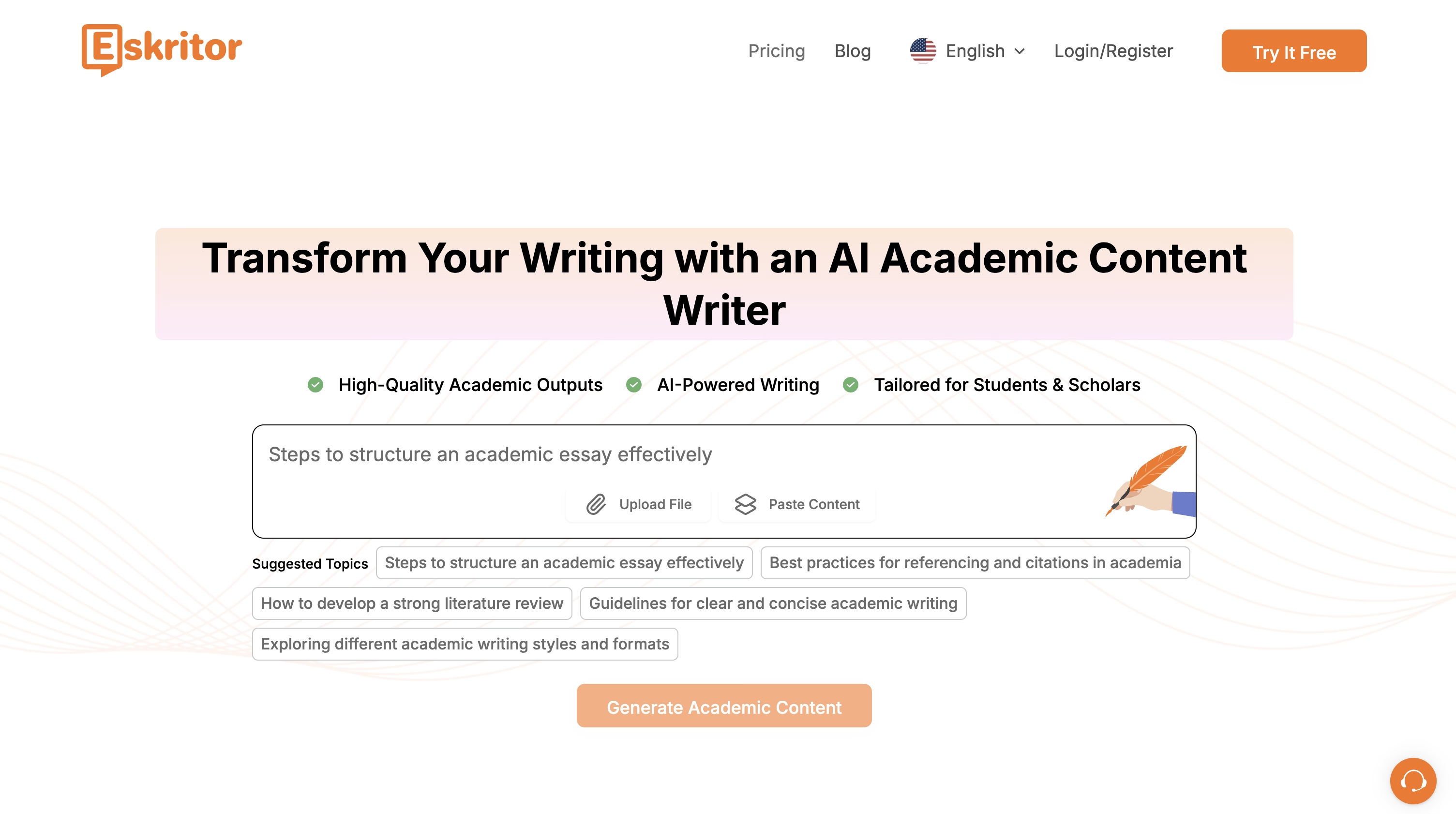
8 Best Persuasive Writing Techniques
Generate the Best Content with AI in Seconds
Generate the Best Content with AI in Seconds
Persuasive writing transforms ordinary content into compelling messages that influence behavior and inspire action. By combining psychological insight with strategic language, persuasive writing enables content creators to shape opinions, drive engagement, and achieve meaningful outcomes. Whether you're writing marketing copy, editorial content, or public communications, mastering persuasive techniques is essential for making a lasting impact.
To build a strong foundation and achieve effective sentence expansion, here’s a concise overview of the eight most effective persuasive writing techniques every writer should know:
- Create a Strong Emotional Connection: Use emotion-driven storytelling to build empathy and drive action.
- Leverage Social Proof to Build Trust: Reinforce credibility through testimonials, case studies, and data.
- Craft Compelling Arguments with Logic: Structure your reasoning with evidence and address objections head-on.
- Use Rhetorical Devices for Impact: Enhance memorability and rhythm with powerful language patterns.
- Understand and Address Your Audience: Tailor content to audience needs, preferences, and pain points.
- Develop a Persuasive Content Structure: Use frameworks like AIDA or PAS to guide readers from problem to solution.
- Master Persuasive Language Patterns: Choose strong, sensory, and active language that triggers the response.
- Create Irresistible Calls to Action: Direct readers with clear, compelling CTAs that align with their journey.
What Is Persuasive Writing?
Persuasive writing influences reader opinions, beliefs, or actions through compelling arguments and strategic communication. Unlike informative writing, persuasive writing focuses on convincing audiences rather than merely providing information. The purpose centers on motivating readers to adopt viewpoints, whether you need to [summarize articles](https://eskritor.com/how-to-summarize-articles/) or take specific actions after engaging with content.
Effective persuasive writing combines key elements:
- Evidence-based arguments supporting main claims
- Appeals to both emotion and logic
- Consideration of audience needs and objections
- Clear structure guiding readers toward conclusions
- Compelling language resonating with target readers
- Credibility-building techniques establish authority
Persuasive writing appears across multiple formats, including marketing materials, sales pages, political speeches, opinion pieces, academic essays, and advertising copy. While techniques vary by audience and medium, core persuasion principles remain consistent.
What Are the Benefits of Persuasive Writing?
Persuasive writing delivers significant benefits for businesses, marketers, and communicators through:
- Increased Conversion Rates : Compelling readers to take desired actions, from purchases to subscriptions
- Enhanced Brand Authority : Establishing brands as industry thought leaders
- Improved Engagement : Creating stronger connections through emotional appeals and relevant messaging
- Effective Communication : Delivering messages with maximum impact
- Better Customer Relationships : Demonstrating understanding by addressing audience needs
- Competitive Advantage : Standing out from competitors with less compelling messaging
- Higher ROI : Generating better results for the same content investment
Research by Nielsen Norman Group shows that persuasive content with emotional appeals generates 23% higher engagement compared to purely informational content.
What Is the Psychology Behind Persuasive Writing?
Persuasive writing operates on understanding human psychology and decision-making. Effective persuasive content connects with readers emotionally and logically, creating compelling cases for desired actions.
The foundation rests on three elements identified by Aristotle: ethos (credibility), pathos (emotional appeal), and logos (logical reasoning). Modern research expands these concepts with additional insights into effective persuasion techniques.
Effective persuasive writing addresses audience's needs and pain points directly. By demonstrating understanding of reader challenges, persuasive writing establishes relevance and creates connections upon which persuasive arguments build maximum impact.
Key psychological principles in persuasive writing:
- People decide emotionally first, then justify with logic
- Trust and credibility are prerequisites for persuasion
- Structured, digestible formats increase comprehension
- Addressing objections proactively strengthens arguments
What Are the Most Effective Persuasive Writing Techniques?
The most effective persuasive writing combines multiple persuasive writing strategies to create a compelling, multifaceted argument. Each of these eight essential techniques addresses a different aspect of the persuasion process, from establishing emotional connections to structuring your arguments for maximum impact.
Create a Strong Emotional Connection
Emotional appeal in writing is often the most powerful element of persuasive content. Content that evokes emotion creates a deeper, more memorable impression and motivates action more effectively than purely factual information.

To create strong emotional connections in your writing:
- Identify which emotions align with your message (hope, fear, excitement, etc.)
- Use vivid, sensory-rich storytelling to make readers feel they're experiencing the situation
- Connect your solution directly to emotional relief or fulfillment
- Balance emotional appeals with authentic, sincere language that doesn't feel manipulative
Research from Nielsen Norman Group demonstrates that content with emotional relevance receives significantly more attention and engagement. When readers feel emotionally invested, they're more likely to continue reading and ultimately take your desired action.
For example, a climate change article that simply presents statistics about rising temperatures might inform readers, but one that describes the potential impact on future generations creates an emotional investment that drives action.
Leverage Social Proof to Build Trust
Building credibility in writing is essential for persuasive content. Readers are naturally skeptical of claims without supporting evidence, especially when they come from unfamiliar sources. Social proof bridges this credibility gap by showing that others have already validated your claims.
Effective types of social proof include:
- Customer testimonials and reviews
- Case studies with specific, measurable results
- Expert endorsements from recognized authorities
- Statistical data showing widespread adoption
- Media mentions and third-party coverage
When incorporating social proof, specificity matters. According to marketing research, specific testimonials (e.g., "We increased conversions by 37% in three months") are significantly more persuasive than general statements (e.g., "This is a great product").
Place social proof strategically throughout your content, particularly after making important claims or before calls to action. This positioning reinforces your credibility at critical decision points in the reader's journey.
Craft Compelling Arguments with Logic
While emotional appeals create initial interest, writing compelling arguments provides the substance that convinces readers to take action. Writing compelling arguments requires a clear structure that connects evidence directly to your claims.
To create logically persuasive content:
- Start with a clear thesis or central argument
- Support each point with relevant evidence (statistics, examples, expert opinions)
- Address potential counterarguments proactively
- Use deductive reasoning to guide readers to inevitable conclusions
- Ensure all claims are substantiated and avoid logical fallacies
The strongest arguments acknowledge potential objections and address them directly. This approach demonstrates confidence in your position and shows readers you've considered multiple perspectives.
For instance, if you're arguing for a particular productivity approach, acknowledge its limitations before explaining why the benefits outweigh them. This balanced presentation builds credibility and preempts reader objections.
Use Rhetorical Devices for Impact
Rhetorical devices in persuasive writing are special patterns of words and structures that make your content more memorable and effective. These techniques have been used by effective communicators for centuries to enhance their messages.
Some of the most effective rhetorical devices include:
- Repetition: Reinforcing key points or phrases (e.g., "Yes, we can" in Obama's speeches)
- Contrast: Highlighting differences between options (e.g., "Ask not what your country can do for you, but what you can do for your country")
- Tricolon: Using groups of three (e.g., "Government of the people, by the people, for the people")
- Metaphor: Creating powerful mental images through comparison
- Rhetorical questions: Engaging readers by prompting internal reflection
When using rhetorical devices, subtlety is key. They should enhance your message naturally without calling attention to themselves. Used effectively, rhetorical devices create rhythm and emphasis that make your key points more impactful and memorable.
In marketing, rhetorical devices frequently appear in slogans and taglines. Apple's famous "Think Different" campaign uses contrast and brevity to create a memorable, impactful message that aligns with the brand's identity.
Understand and Address Your Audience
Effective audience analysis for persuasive content begins with a deep understanding of your readers. Without this foundation, even the most eloquent arguments will fail to resonate or motivate action.

To develop audience-focused, persuasive content:
- Create detailed audience personas with demographic and psychographic information
- Research the specific language, concerns, and values of your target audience
- Anticipate potential objections based on audience characteristics
- Adjust your tone, examples, and evidence to match audience preferences
- Test your assumptions through surveys, interviews, or content testing
When addressing different audience segments, consider tailoring separate content pieces rather than trying to appeal to everyone simultaneously. A message crafted specifically for a well-defined audience will always outperform generic content.
For example, when writing about retirement planning, content for millennials might emphasize long-term compound growth and digital tools, while content for baby boomers might focus on immediate strategies and security concerns.
Develop a Persuasive Content Structure
A persuasive content structure significantly impacts your writing's effectiveness. A well-organized structure guides readers logically through your argument, anticipates and addresses potential objections, and leads naturally to your desired conclusion.
Several proven frameworks for persuasive content include:
- Problem-Agitate-Solution (PAS): Identify a problem, amplify the negative consequences, then present your solution
- Attention, Interest, Desire, Action (AIDA): Capture attention with a hook, build interest with relevant information, create desire by highlighting benefits, and prompt specific action
- Before-After-Bridge (BAB): Describe the current situation, paint a picture of a better future, then explain how to get there
- Feature-Advantage-Benefit (FAB): Explain what a product/service is, why it matters, and how it specifically helps the reader
Choose a structure based on your specific persuasion goals and audience preferences. For shorter content like emails or social posts, simpler frameworks like PAS work well. For complex arguments, more elaborate structures with multiple supporting points may be necessary.
Regardless of the framework you choose, ensure your content flows logically from one point to the next, with clear transitions and a coherent progression toward your conclusion.
Master Persuasive Language Patterns
Persuasive language techniques and the specific words you choose significantly impact your content's effectiveness. Persuasive language patterns leverage linguistic psychology to enhance your message's impact.
To improve your persuasive language:
- Use power words that evoke emotion (e.g., "guaranteed," "exclusive," "proven")
- Incorporate sensory language that helps readers visualize and experience your message
- Write in active voice for clarity and impact
- Replace weak qualifiers ("somewhat," "fairly") with confident language
- Use concrete, specific terms rather than vague generalizations
- Incorporate "you" and "your" to make content personally relevant
Research by conversion optimization experts shows that changing just a few words can significantly impact response rates. For example, adding the word "because" followed by a reason can increase compliance with requests, even when the reason itself is obvious.
Apply persuasive language patterns throughout your content, but particularly in headlines, subheadings, calls to action, and key argument statements where impact matters most.
Create Irresistible Calls to Action
Even the most persuasive content fails without effective call to action writing that clearly directs readers toward the next step. Effective calls to action (CTAs) bridge the gap between persuasion and action.
To create high-converting CTAs:
- Use action-oriented, specific verbs (e.g., "Download," "Register," "Start," not "Click here")
- Create a sense of urgency or scarcity when appropriate
- Highlight the immediate value readers will receive
- Remove friction by addressing potential hesitations
- Test different placements, formats, and wording
The most effective CTAs align perfectly with the preceding content. They feel like a natural next step rather than an abrupt sales pitch. This alignment requires considering the reader's stage in the decision journey and offering an appropriate next action.
For instance, readers just learning about a topic might respond better to "Get our free guide" than "Buy now," which would be more appropriate for content targeting readers already convinced of their need. To enhance your skills in this area, consider exploring copywriting courses that offer practical insights and techniques.
How AI Tools Are Revolutionizing Persuasive Writing?
Artificial intelligence is transforming persuasive writing by providing tools that can analyze, enhance, and even generate persuasive content, similar to techniques in direct response copywriting. These technologies help writers create more effective content in less time.
Modern AI writing tools offer several benefits for persuasive content creation:
- Data-driven insights about what language patterns drive engagement
- Templates based on proven persuasive structures
- Tone and style adjustments to match specific audience preferences
- Content enhancement with supporting facts and examples
- Real-time feedback on readability and impact
When evaluating AI writing tools for persuasive content, look for features that specifically support persuasion:
- Customizable templates for different persuasive frameworks
- Tone adjustment capabilities for different audience segments
- Enhancement tools that add credibility and emotional impact
- Multi-format support for various content types
- Seamless editing and refinement capabilities
Eskritor: The Ultimate Tool for Creating Persuasive Content
Eskritor offers specialized features explicitly designed to enhance persuasive writing effectiveness. This AI-powered writing platform helps content creators, marketers, and business professionals craft compelling, persuasive content more efficiently.

Eskritor's key features for persuasive writing include:
- Custom prompts that allow you to specify persuasive tones and styles for different audiences
- Content enrichment that automatically adds supporting evidence, examples, and data points to strengthen arguments
- Rewriting and enhancement capabilities that improve the impact of your persuasive language
- AI-powered editing suggestions that identify opportunities to increase the persuasive impact
Using Eskritor for persuasive writing is straightforward:
- Start with your basic topic or argument
- Select a persuasive content prompt that matches your goals
- Customize the tone and style to align with your audience
- Review the AI-generated draft and make any necessary adjustments
- Use the enhancement tools to strengthen emotional appeals and logical arguments
- Finalize your persuasive content with confidence
Conclusion
Mastering persuasive writing techniques is essential for creating content that not only captures attention but also drives meaningful action, and integrating useful AI writing tools can enhance the effectiveness of your content strategy. By understanding the psychology behind persuasion and implementing the eight key techniques we've explored, you can significantly enhance your content's impact.
The challenges of persuasive writing are real, but tools like Eskritor now make it easier than ever to create compelling, persuasive content efficiently. With its AI-powered features specifically designed to enhance persuasive elements, Eskritor helps writers at all experience levels craft more effective messaging.
Ready to take your persuasive writing to the next level? Try Eskritor today and discover how its specialized features can help you create content that truly resonates and motivates your audience to act.
Frequently Asked Questions
Persuasive writing specifically aims to influence readers' opinions or actions through emotional appeal, logical arguments, and credibility building. Unlike informative writing that simply presents facts, persuasive writing strategically uses language patterns and content structure to drive readers toward a desired conclusion or action.
Enhance emotional appeal by using sensory-rich language, personal stories, and vivid examples that connect to readers' experiences. Identify which emotions (hope, fear, curiosity) align with your message, then craft descriptions that evoke those feelings while maintaining authenticity and avoiding manipulation.
Eskritor's AI-powered platform offers custom prompts for crafting persuasive tones, content enrichment tools for adding supporting evidence, and rewriting capabilities to enhance persuasive impact.
Create effective calls to action by using specific, action-oriented verbs, highlighting immediate value, and creating appropriate urgency. Align your CTA with the preceding content so it feels like a natural next step, and test different placements and wording to determine what resonates best with your specific audience.
The best AI tool for writing persuasive content is Eskritor. It provides tailored prompts for emotional tone, content structuring based on persuasion frameworks like AIDA and PAS, and enrichment tools that insert data-backed arguments and rhetorical devices. Writers can also use Eskritor to test different CTAs and optimize impact.





 location
location